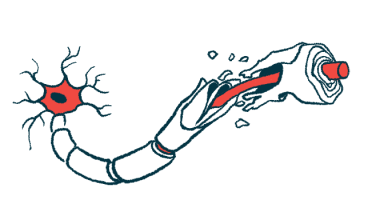Novel MPZ Gene Mutations Causing CMT1B in Chinese Patients

Two newly reported mutations in the MPZ gene resulted in Charcot-Marie-Tooth (CMT) disease type 1B in Chinese patients, according to a recent study.
Taken together with previous cases, the findings further show the diversity of MPZ mutations in Chinese patients, the scientists said.
The study, “Two Novel Myelin Protein Zero Mutations in a Group of Chinese Patients,” was published in the journal Frontiers in Neurology.
CMT is an inherited disorder of the peripheral nervous system — the network of nerves that supply movement and sensation to the arms and legs — and is characterized by slow-progressing weakness, muscle wasting, and sensory impairment.
It is classified into various subtypes based on which genes are mutated, the way the disease is inherited, and the speed at which the electrical impulses (messages) move through the nerves — the nerve conduction speed.
Myelin point zero (MPZ) is an abundant protein within myelin, which is the protective covering surrounding nerve fibers. MPZ functions as an adhesion molecule and mediates the compaction of the peripheral nervous system.
Nearly 300 MPZ mutations have been identified. They cause autosomal dominant CMT, where having just one mutated gene copy is enough to result in disease. Autosomal dominant CMT can be divided into CMT1B, CMT2I, and Dejerine-Sottas syndrome (rarely called CMT3), based on the clinical and electrophysiological characteristics, such as nerve conduction speed.
The study looked at six different probands — individuals used as the starting point for a family genetic study — from unrelated Chinese families between January 2012 and August 2019 with suspected CMT or related mutations in CMT genes based on DNA analysis.
The probands included five males and one female. All males had an age of disease onset greater than 40, whereas the female’s was 16. All patients experienced limb weakness as their first symptom, and all had lower limb muscle wasting with pes cavus, which is a foot deformity characterized by a high foot arch.
Patients 1, 5, and 6 had family histories of peripheral neuropathy — weakness, numbness, or pain in peripheral nerves.
At 43 years old, patient 1 started experiencing weakness in both lower limbs, and three years later had slower walking than before. His father also showed lower limb weakness in his 40s.
Patient 5 had a history of abnormal gait for three years. Both his mother and sister showed similar symptoms.
The third patient (patient 6) had a history of sprained ankles at age 16, and both his grandfather and father developed abnormal walking in their 40s.
The other three patients did not have family members available for testing.
Patient 2 had lower limb weakness for 14 years, with increased progression over the past two years. Another patient (patient 3) had an 11-year history of lower limb weakness, and in the past two years had started experiencing hand weakness. Patient 4 had abnormal gait for 12 years.
In all patients, assessing electrical responses showed sensorimotor demyelinating polyneuropathy, which means a decreased ability to move or feel (sensation) because of myelin loss in nerves.
Multiple nerves involved in movement showed decreased conduction speed, which contributed to a diagnosis of CMT1 in all participants.
Genetic analysis found six different mutations in the MPZ gene, four known and two unknown — not found in databases nor in 8,000 healthy Chinese controls.
Specifically, the newly reported mutations comprised a frameshift mutation in patient 2, c.79delG (p. A27fs), and an intronic splice variant in patient 1 and his father.
Frameshift mutations involve the deletion or insertion of a DNA bulding block that shifts the way the sequence is read. In patient 2, the frameshift mutation led to one of the protein building blocks (an amino acid) being changed to the signal for stopping protein production. This mutation was deemed to be disease-causing based on loss of protein function, its absence in controls, and its harmful effect on the gene and gene products. It resulted in a mild disease course.
As for intronic splice variants, they occur in the DNA bits that do not code for proteins (introns) and can affect the way RNA is spliced for creating proteins. In patient 1 and his father, the mutation was in intron 1 and was associated with rapid progression in the late stage of the disease. It too was deemed likely the cause of the disease due to its location in the gene, its absence from controls, its co-segregation in the family (where those affected have the mutation and the unaffected do not), and its harmful effects on the gene or gene products.
“Both novel variants were not seen in healthy individuals with no known history of neurogenetic diseases or in multiple databases, which further suggested that [they] are disease-causing rather than normal variants of MPZ,” the researchers wrote.
Upon further analysis of the literature, the team found that the most common mutation type among the 28 mutations identified in Chinese individuals was the missense mutation, which results in a different amino acid in the protein product. Among the 28 mutations, 75% were missense mutations, followed by frameshift mutations in 17.8%, and splice site mutations in introns in 7.2%.
“Our study further confirmed that MPZ mutations are associated with specific phenotypes [characteristics], especially at the age of onset,” the researchers wrote. “In general, CMT1B patients in this study with MPZ mutations had relatively mild clinical phenotypes.”
“This report will help with genetic and clinical studies of Chinese CMT patients with MPZ mutations,” the investigators concluded.






